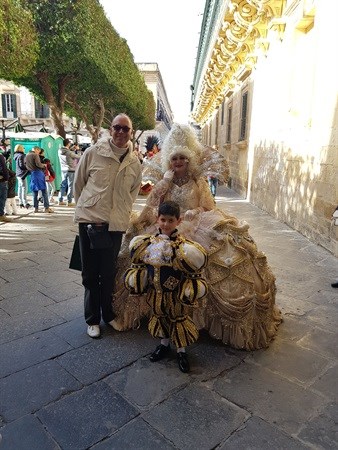A South African's guide to moving to and making it in Malta: A Karnival of optimism
Let’s start with the annual Karnival celebrations which take place over five days in February – the traditional 40 days before Easter. The only cloud on the scheduling horizon was that we had heavy storms that disgorged February’s entire average precipitation in just 36 hours. That meant that wind and rain stopped play for the first two days of Karnival 2018, but when the clouds parted, the revelry began.
Different cakes, same food colouring
Karnival presents in three different ways. Firstly, the exuberantly modelled floats which are built in open-sided hangars outside Valletta. There is a very specific style of modelling the giant figures and an equally specific neon colour palate so that even though each float’s theme is different, when massed together, they all look very similar – almost as if everyone was baking different cakes but only had access to the same food colouring! Floats are judged according to thematic category: triumphal, satiric, company, etc.
Secondly, there are the troupes with costumes so spectacular, I wonder why anyone bothers taking the family to Disneyland Paris. I say spectacular for three reasons: creativity, cost and impractability!

Here at Karnival, it’s as if somebody upended Alice’s rabbit hole and all of Lewis Carroll’s characters came spilling out. Courtiers and queens, rearing horses, Eiffel Towers and Big Bens as well as a full panoply of period costume re-enactments from Malta’s history. To call these looks ‘outfits’ would be to do them a disservice; most of the creations are wearable sculptures attached to the body by a harness and then run up in a glorious panoply of stiff brocades, sumptuous velvets, dizzying sequins, shiny taffetas, gleaming silks and rhinestone-encrusted feathers.
Karnival creations can cost up to €1,000 (R15,000) and they are gloriously impractical being both high and wide. I have no idea how you would travel to Valletta wearing them and am amazed that with the press of cellphone wielding selfie-takers, the attire isn’t inadvertently destroyed when wading through the crowded streets of the capital. These creations are largely worn by grown-ups – mostly women – who ‘gather the troupes’ in St George’s Square to competitively line dance in their upholstered finery to the strains of something retro-fabulous like Hernando’s Hideaway or the Abba songbook. At all times, the dancers are resiliently pleasant and red-carpet ready for endlessly posing for photos with visitors.

A portrait gallery come to life
By far my favourite part of Karnival, however, are the children. Although there are some dancing schools that send in costumed teams of tots (think Anne Geddes-inspired wardrobes), Maltese families with small children like to dress them up and wheel out the pushchairs through the baroque streets of Valletta. We’re not talking about Superman pyjamas or dinosaur onesies here, these are more likely to be French musketeers or Spanish Infantas, as if a portrait gallery in the Grandmaster’s Palace had come to life. The Maltese people are very, very family oriented and Karnival is an adult expression of a child’s fantasy!
EU’s highest GDP forecast
The whole island had good reason for optimism this past week. According to the European Commission’s Winter 2018 Interim Economic Forecast, Malta’s GDP growth rate is the highest in the EU and more than double that of the European economy.
Malta’s growth rate is projected to hit 5.6% in 2018 and 4.5% in 2019.
The EC reacted favourably to Malta’s real GDP growth in the first three quarters of 2017, which reached 7.2%. They attributed this to the external sector, driven by growing services exports.
On growth for 2018, the EC expects private consumption to become the main driver of growth off the back of strong employment growth, improved consumer confidence and growing disposable income.
Business takeout: Malta’s EC-predicted future rate of growth will be more than double the archipelago’s average growth rate between 2009 and 2013.
The social take-home: The typical Karnival dessert treat is the prinjolata. Made with pine nuts, pistachios, hazelnuts, almonds, honey and sized like a Swiss roll covered with white icing and glacé cherries, it has the consistency of a dry, crumbly nougat. Aficionados agree, the best prinjolatas come from Busy Bee and Caffe Cordina in Valletta.


























